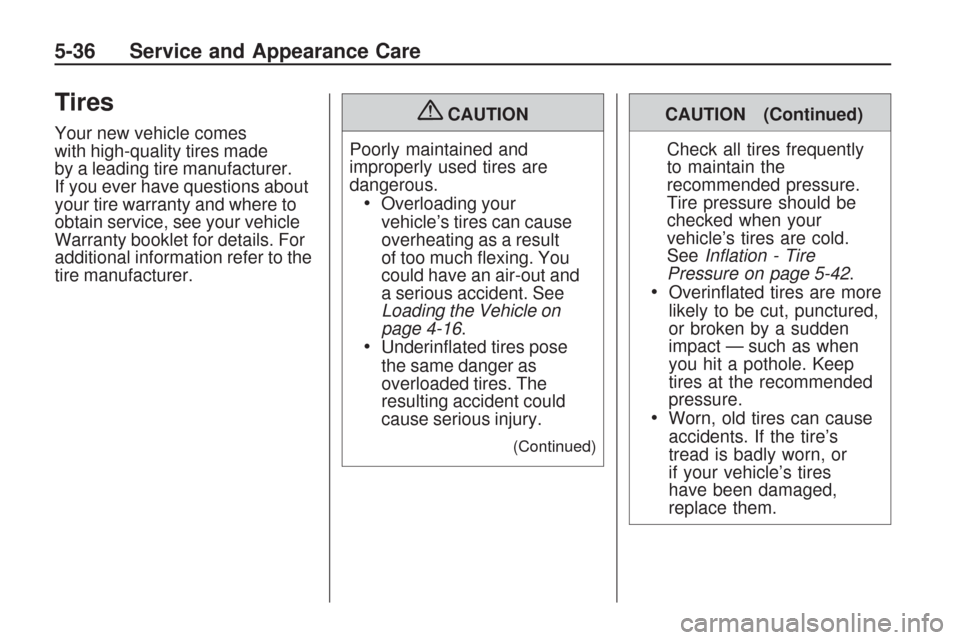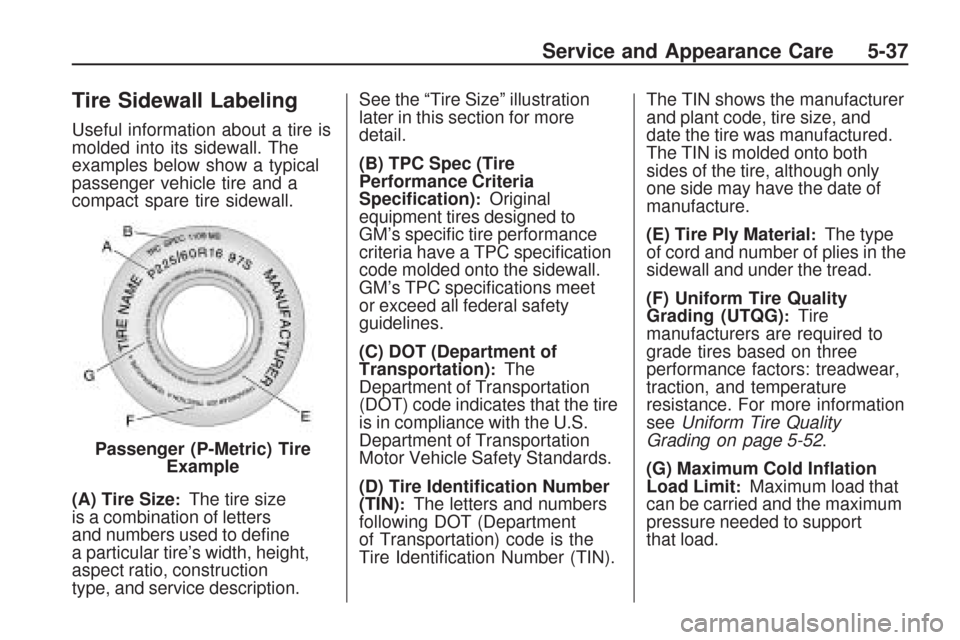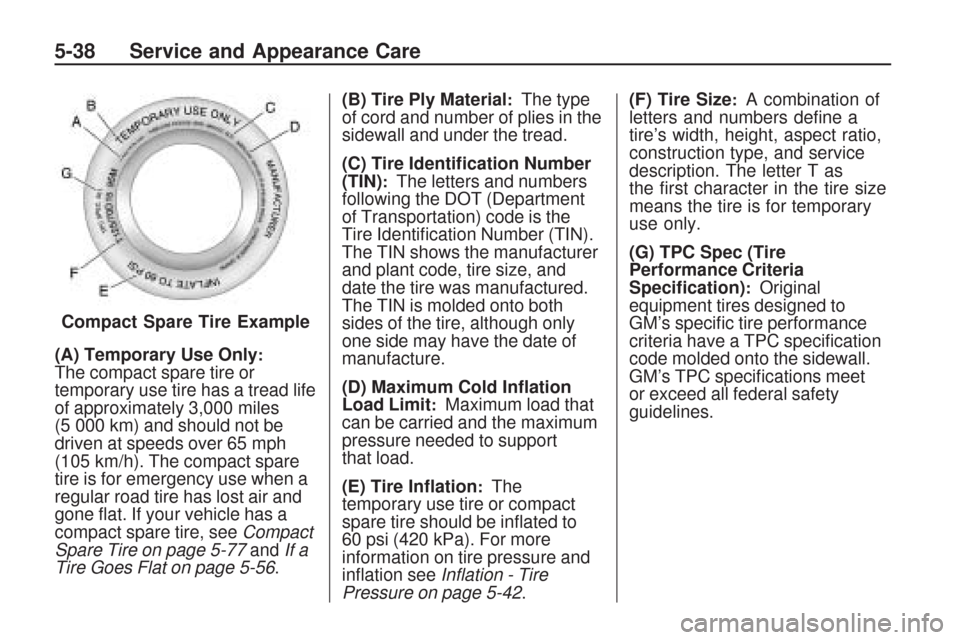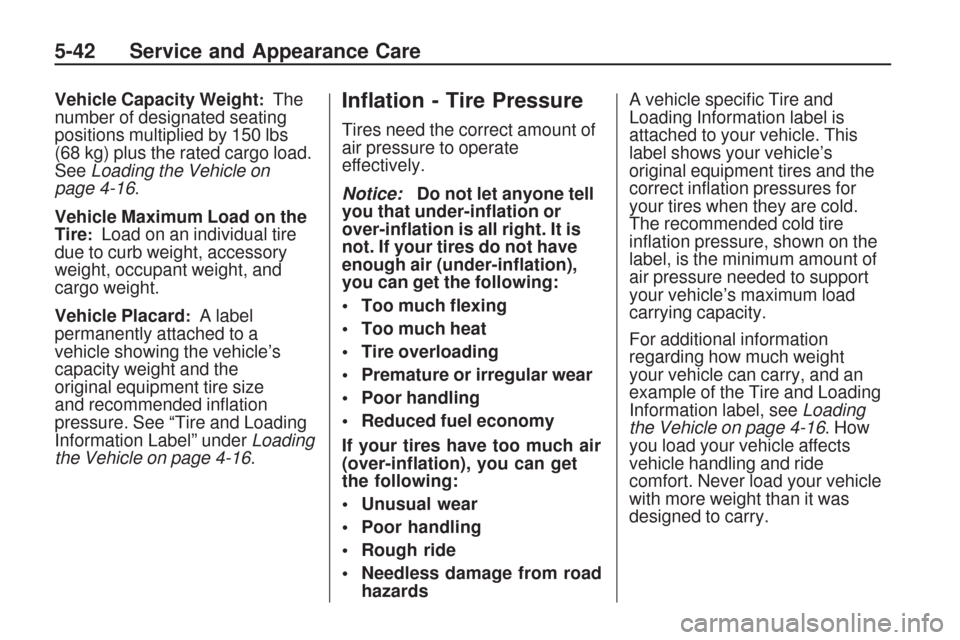2009 CHEVROLET TRAVERSE tires
[x] Cancel search: tiresPage 318 of 422

Tires
Your new vehicle comes
with high-quality tires made
by a leading tire manufacturer.
If you ever have questions about
your tire warranty and where to
obtain service, see your vehicle
Warranty booklet for details. For
additional information refer to the
tire manufacturer.
{CAUTION
Poorly maintained and
improperly used tires are
dangerous.
Overloading your
vehicle’s tires can cause
overheating as a result
of too much �exing. You
could have an air-out and
a serious accident. See
Loading the Vehicle on
page 4-16.
Underin�ated tires pose
the same danger as
overloaded tires. The
resulting accident could
cause serious injury.
(Continued)
CAUTION (Continued)
Check all tires frequently
to maintain the
recommended pressure.
Tire pressure should be
checked when your
vehicle’s tires are cold.
SeeInflation - Tire
Pressure on page 5-42.
Overin�ated tires are more
likely to be cut, punctured,
or broken by a sudden
impact — such as when
you hit a pothole. Keep
tires at the recommended
pressure.
Worn, old tires can cause
accidents. If the tire’s
tread is badly worn, or
if your vehicle’s tires
have been damaged,
replace them.
5-36 Service and Appearance Care
Page 319 of 422

Tire Sidewall Labeling
Useful information about a tire is
molded into its sidewall. The
examples below show a typical
passenger vehicle tire and a
compact spare tire sidewall.
(A) Tire Size
:The tire size
is a combination of letters
and numbers used to de�ne
a particular tire’s width, height,
aspect ratio, construction
type, and service description.See the “Tire Size” illustration
later in this section for more
detail.
(B) TPC Spec (Tire
Performance Criteria
Speci�cation)
:Original
equipment tires designed to
GM’s speci�c tire performance
criteria have a TPC speci�cation
code molded onto the sidewall.
GM’s TPC speci�cations meet
or exceed all federal safety
guidelines.
(C) DOT (Department of
Transportation)
:The
Department of Transportation
(DOT) code indicates that the tire
is in compliance with the U.S.
Department of Transportation
Motor Vehicle Safety Standards.
(D) Tire Identi�cation Number
(TIN)
:The letters and numbers
following DOT (Department
of Transportation) code is the
Tire Identi�cation Number (TIN).The TIN shows the manufacturer
and plant code, tire size, and
date the tire was manufactured.
The TIN is molded onto both
sides of the tire, although only
one side may have the date of
manufacture.
(E) Tire Ply Material
:The type
of cord and number of plies in the
sidewall and under the tread.
(F) Uniform Tire Quality
Grading (UTQG)
:Tire
manufacturers are required to
grade tires based on three
performance factors: treadwear,
traction, and temperature
resistance. For more information
seeUniform Tire Quality
Grading on page 5-52.
(G) Maximum Cold In�ation
Load Limit
:Maximum load that
can be carried and the maximum
pressure needed to support
that load. Passenger (P-Metric) Tire
Example
Service and Appearance Care 5-37
Page 320 of 422

(A) Temporary Use Only:The compact spare tire or
temporary use tire has a tread life
of approximately 3,000 miles
(5 000 km) and should not be
driven at speeds over 65 mph
(105 km/h). The compact spare
tire is for emergency use when a
regular road tire has lost air and
gone �at. If your vehicle has a
compact spare tire, seeCompact
Spare Tire on page 5-77andIf a
Tire Goes Flat on page 5-56.(B) Tire Ply Material
:The type
of cord and number of plies in the
sidewall and under the tread.
(C) Tire Identi�cation Number
(TIN)
:The letters and numbers
following the DOT (Department
of Transportation) code is the
Tire Identi�cation Number (TIN).
The TIN shows the manufacturer
and plant code, tire size, and
date the tire was manufactured.
The TIN is molded onto both
sides of the tire, although only
one side may have the date of
manufacture.
(D) Maximum Cold In�ation
Load Limit
:Maximum load that
can be carried and the maximum
pressure needed to support
that load.
(E) Tire In�ation
:The
temporary use tire or compact
spare tire should be in�ated to
60 psi (420 kPa). For more
information on tire pressure and
in�ation seeInflation - Tire
Pressure on page 5-42.(F) Tire Size
:A combination of
letters and numbers de�ne a
tire’s width, height, aspect ratio,
construction type, and service
description. The letter T as
the �rst character in the tire size
means the tire is for temporary
use only.
(G) TPC Spec (Tire
Performance Criteria
Speci�cation)
:Original
equipment tires designed to
GM’s speci�c tire performance
criteria have a TPC speci�cation
code molded onto the sidewall.
GM’s TPC speci�cations meet
or exceed all federal safety
guidelines. Compact Spare Tire Example
5-38 Service and Appearance Care
Page 323 of 422

Maximum Loaded Vehicle
Weight:The sum of curb
weight, accessory weight,
vehicle capacity weight, and
production options weight.
Normal Occupant Weight
:The
number of occupants a vehicle
is designed to seat multiplied by
150 lbs (68 kg). SeeLoading
the Vehicle on page 4-16.
Occupant Distribution
:Designated seating positions.
Outward Facing Sidewall
:The
side of an asymmetrical tire that
has a particular side that faces
outward when mounted on a
vehicle. The side of the tire that
contains a whitewall, bears white
lettering, or bears manufacturer,
brand, and/or model name
molding that is higher or deeper
than the same moldings on the
other sidewall of the tire.Passenger (P-Metric) Tire
:A tire used on passenger cars
and some light duty trucks and
multipurpose vehicles.
Recommended In�ation
Pressure
:Vehicle
manufacturer’s recommended
tire in�ation pressure as
shown on the tire placard. See
Inflation - Tire Pressure on
page 5-42andLoading the
Vehicle on page 4-16.
Radial Ply Tire
:A pneumatic
tire in which the ply cords that
extend to the beads are laid at
90 degrees to the centerline of
the tread.
Rim
:A metal support for a tire
and upon which the tire beads
are seated.
Sidewall
:The portion of a tire
between the tread and the bead.
Speed Rating
:An alphanumeric
code assigned to a tire indicating
the maximum speed at which a
tire can operate.Traction
:The friction between
the tire and the road surface.
The amount of grip provided.
Tread
:The portion of a tire that
comes into contact with the road.
Treadwear Indicators
:Narrow
bands, sometimes called wear
bars, that show across the tread
of a tire when only 1/16 inch
(1.6 mm) of tread remains. See
When It Is Time for New Tires on
page 5-50.
UTQGS (Uniform Tire Quality
Grading Standards)
:A tire
information system that provides
consumers with ratings for a tire’s
traction, temperature, and
treadwear. Ratings are
determined by tire manufacturers
using government testing
procedures. The ratings are
molded into the sidewall of the
tire. SeeUniform Tire Quality
Grading on page 5-52.
Service and Appearance Care 5-41
Page 324 of 422

Vehicle Capacity Weight:The
number of designated seating
positions multiplied by 150 lbs
(68 kg) plus the rated cargo load.
SeeLoading the Vehicle on
page 4-16.
Vehicle Maximum Load on the
Tire
:Load on an individual tire
due to curb weight, accessory
weight, occupant weight, and
cargo weight.
Vehicle Placard
:A label
permanently attached to a
vehicle showing the vehicle’s
capacity weight and the
original equipment tire size
and recommended in�ation
pressure. See “Tire and Loading
Information Label” underLoading
the Vehicle on page 4-16.
In�ation - Tire Pressure
Tires need the correct amount of
air pressure to operate
effectively.
Notice:Do not let anyone tell
you that under-in�ation or
over-in�ation is all right. It is
not. If your tires do not have
enough air (under-in�ation),
you can get the following:
Too much �exing
Too much heat
Tire overloading
Premature or irregular wear
Poor handling
Reduced fuel economy
If your tires have too much air
(over-in�ation), you can get
the following:
Unusual wear
Poor handling
Rough ride
Needless damage from road
hazardsA vehicle speci�c Tire and
Loading Information label is
attached to your vehicle. This
label shows your vehicle’s
original equipment tires and the
correct in�ation pressures for
your tires when they are cold.
The recommended cold tire
in�ation pressure, shown on the
label, is the minimum amount of
air pressure needed to support
your vehicle’s maximum load
carrying capacity.
For additional information
regarding how much weight
your vehicle can carry, and an
example of the Tire and Loading
Information label, seeLoading
the Vehicle on page 4-16. How
you load your vehicle affects
vehicle handling and ride
comfort. Never load your vehicle
with more weight than it was
designed to carry.
5-42 Service and Appearance Care
Page 325 of 422

When to Check
Check your tires once a month
or more. Do not forget to check
the compact spare tire, if the
vehicle has one. It should be at
60 psi (420 kPa). For additional
information regarding the
compact spare tire, seeCompact
Spare Tire on page 5-77.
How to Check
Use a good quality pocket-type
gage to check tire pressure.
You cannot tell if your tires are
properly in�ated simply by
looking at them. Radial tires may
look properly in�ated even when
they are under-in�ated. Check
the tire’s in�ation pressure when
the tires are cold. Cold means
your vehicle has been sitting for
at least three hours or driven no
more than 1 mile (1.6 km).Remove the valve cap from
the tire valve stem. Press the
tire gage �rmly onto the valve to
get a pressure measurement.
If the cold tire in�ation pressure
matches the recommended
pressure on the Tire and Loading
Information label, no further
adjustment is necessary. If the
in�ation pressure is low, add air
until you reach the recommended
amount.
If you over�ll the tire, release
air by pushing on the metal stem
in the center of the tire valve.
Re-check the tire pressure with
the tire gage.
Be sure to put the valve caps
back on the valve stems.
They help prevent leaks by
keeping out dirt and moisture.Tire Pressure Monitor
System
The Tire Pressure Monitor System
(TPMS) uses radio and sensor
technology to check tire pressure
levels. The TPMS sensors monitor
the air pressure in your vehicle’s tires
and transmit tire pressure readings to
a receiver located in the vehicle.
Each tire, including the spare
(if provided), should be checked
monthly when cold and in�ated to
the in�ation pressure recommended
by the vehicle manufacturer on the
vehicle placard or tire in�ation
pressure label. (If your vehicle has
tires of a different size than the size
indicated on the vehicle placard or
tire in�ation pressure label, you
should determine the proper tire
in�ation pressure for those tires.)
Service and Appearance Care 5-43
Page 326 of 422

As an added safety feature, your
vehicle has been equipped with a tire
pressure monitoring system (TPMS)
that illuminates a low tire pressure
telltale when one or more of your
tires is signi�cantly under-in�ated.
Accordingly, when the low tire
pressure telltale illuminates, you
should stop and check your tires
as soon as possible, and in�ate
them to the proper pressure. Driving
on a signi�cantly under-in�ated tire
causes the tire to overheat and can
lead to tire failure. Under-in�ation
also reduces fuel efficiency and tire
tread life, and may affect the
vehicle’s handling and stopping
ability.
Please note that the TPMS is
not a substitute for proper tire
maintenance, and it is the driver’s
responsibility to maintain correct tire
pressure, even if under-in�ation has
not reached the level to trigger
illumination of the TPMS low tire
pressure telltale.Your vehicle has also been equipped
with a TPMS malfunction indicator
to indicate when the system is not
operating properly. The TPMS
malfunction indicator is combined
with the low tire pressure telltale.
When the system detects a
malfunction, the telltale will �ash for
approximately one minute and then
remain continuously illuminated.
This sequence will continue upon
subsequent vehicle start-ups as
long as the malfunction exists.
When the malfunction indicator
is illuminated, the system may not
be able to detect or signal low tire
pressure as intended. TPMS
malfunctions may occur for a variety
of reasons, including the installation
of replacement or alternate tires or
wheels on the vehicle that prevent
the TPMS from functioning properly.
Always check the TPMS malfunction
telltale after replacing one or more
tires or wheels on your vehicle toensure that the replacement or
alternate tires and wheels allow
the TPMS to continue to function
properly.
SeeTire Pressure Monitor
Operation on page 5-45for
additional information.
Federal Communications
Commission (FCC) and
Industry and Science Canada
The Tire Pressure Monitor System
(TPMS) operates on a radio
frequency and complies with Part 15
of the FCC Rules. Operation is
subject to the following two
conditions:
1. This device may not cause
harmful interference.
2. This device must accept any
interference received, including
interference that may cause
undesired operation.
5-44 Service and Appearance Care
Page 327 of 422

Vehicles with TPMS operate on a
radio frequency and comply with
RSS-210 of Industry and Science
Canada. Operation is subject to the
following two conditions:
1. This device may not cause
interference.
2. This device must accept any
interference received, including
interference that may cause
undesired operation of the device.
Changes or modi�cations to this
system by other than an authorized
service facility could void
authorization to use this equipment.Tire Pressure Monitor
Operation
This vehicle may have a Tire
Pressure Monitor System (TPMS).
The TPMS is designed to warn
the driver when a low tire pressure
condition exists. TPMS sensors
are mounted onto each tire
and wheel assembly, excluding the
spare tire and wheel assembly,
if the vehicle has one. The TPMS
sensors monitor the air pressure in
the vehicle’s tires and transmits
the tire pressure readings to
a receiver located in the vehicle.
When a low tire pressure condition is
detected, the TPMS illuminates the
low tire pressure warning light
located on the instrument panel
cluster.At the same time a message to
check the pressure in a speci�c tire
appears on the Driver Information
Center (DIC) display. The low
tire pressure warning light and the
DIC warning message come on
at each ignition cycle until the tires
are in�ated to the correct in�ation
pressure. Using the DIC, tire
pressure levels can be viewed by
the driver. For additional information
and details about the DIC operation
and displays seeDIC Operation
and Displays (With DIC Buttons) on
page 3-45orDIC Operation and
Displays (Without DIC Buttons) on
page 3-51andDIC Warnings
and Messages on page 3-56.
The low tire pressure warning light
may come on in cool weather when
the vehicle is �rst started, and then
turn off as you start to drive. This
could be an early indicator that the
air pressure in the tire(s) are getting
low and need to be in�ated to the
proper pressure.
Service and Appearance Care 5-45